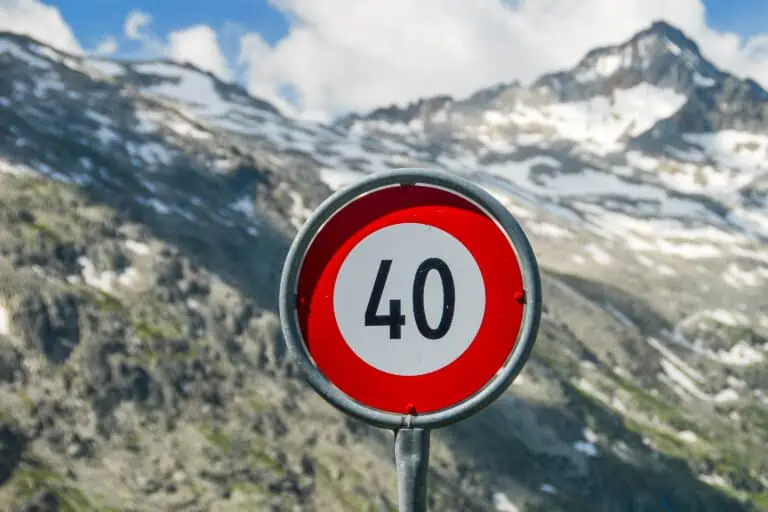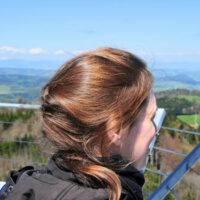The basic rules: right-side driving, motorway vignette and speed
Should I drive on the left or on the right side in Switzerland?
You need to drive on the right lane in Switzerland.
Is the motorway vignette required in Switzerland?
Yes, you need to have a motorway vignette to use the main roads.
What are the speed limits in Switzerland?
Maximum speeds in Switzerland are as follows (exceptions may apply at any time):
- motorway: 120 km/h for cars without a trailer, 100 km/h for cars with a trailer
- highways: 100 km/h
- other roads outside built-up areas: 80 km/h
- towns: 50 km/h in general, 30 km/h in 30 km-zones, 20 km/h in pedestrian priority zones
Are there special rules for driving on Switzerland’s mountain roads?
Definitely! Driving on the (sometimes challenging) Swiss mountain roads requires specific skills and knowledge of the rules. We explain all of this in our guide on driving in the mountains.
Traffic fines
How much does speeding cost in Switzerland?
Traffic fines in Switzerland are impressive. Especially speeding is heavily fined. For example: driving 61 km/h instead of 50 km/h in a town costs CHF 250.
How much do other fines cost in Switzerland?
This very much depends on the gravity of your traffic offense. Just some more examples: not correctly placing your parking disc under your windshield costs CHF 40, ignoring a red traffic light costs CHF 250, and driving with too much alcohol in your blood can easily cost CHF 600 to CHF 800.
Stick to the rules to avoid fines, and much more importantly: to guarantee safety for yourself and others.
More safety rules: seat belts, alcohol, and hands-free calling
Are seat belts and child seats obligatory in Switzerland?
Yes, seat belts are obligatory for all passengers. They must be fastened while the car is moving.
Children under 12 years old need a special seat if they’re under 150 cm tall. The seats must be appropriate for the child’s age and weight, and carry an official ECE security label.
Can I drink and drive in Switzerland?
In general: no, you’d better not. Driving is not allowed from a blood alcohol level of 0.5 mg/l. An absolute alcohol prohibition applies to professional drivers and new drivers. The official maximum for them is 0.1 mg/l.
It is highly recommended to not drink at all when you plan to drive, especially since you’ll be in a foreign country, where you’ll have less experience with the routes and rules than at home.
Can I make a call or use my phone otherwise while driving in Switzerland?
Hands-free calling is allowed in Switzerland, but it is strongly advised against. Handheld calling is prohibited and will be heavily fined.
Priority rules in Switzerland
This is how the Swiss priority rules work, unless indicated otherwise by (road) signs:
- Traffic from the right (including cyclists) has priority.
- Traffic on rotary intersections has priority.
- Police cars, ambulances, and fire trucks with blue lights and sirens always have priority.
- Trams always have priority.
- You’re required to stop for pedestrians who want to use a zebra crossing. Swiss drivers don’t take this rule lightly and usually stop, even if pedestrians are only approaching a crossing. As a tourist, you are expected to do the same, and pedestrians expect to get right of way. Trams don’t need to stop for pedestrians.
- Find priority rules for mountain roads here.
How to use car lights
Should I turn on my headlights in Switzerland even during daytime?
Yes, using your headlights in daytime as well as nighttime is obligatory in Switzerland.
Which other car lights should I use?
Switch to dipped headlights in rain, snow, fog, dark, tunnels, and other low-visibility situations. Only use full beam if there’s no oncoming traffic. Switch back to (dipped) headlights as soon as you spot oncoming traffic.
What to take along in your car
These items should be in your car in Switzerland:
- A warning triangle in each car is obligatory.
- A first aid kit, a fire extinguisher, and safety vests are recommended.
- You don’t have to possess a parking disc, but we do recommend having one.
- A spare wheel is not required, but it can be handy if you’re able to replace a wheel yourself.
Requirements for winter driving in Switzerland
Winter driving in Switzerland requires additional preparation. Find rules and tips here.
Miscellaneous Swiss traffic rules
These are more Swiss traffic regulations to take into account:
- If a driving lane is closed, you have to allow drivers from this closed lane to merge into your lane.
- In case of accidents, quick access for emergency services is required. In slow traffic, drivers have to create a so-called “Rettungsgasse”. This means that one row of cars is being formed on the very left side of the road and one or more rows on the right side. This way, you’ll create an improvised lane in between. You can be fined if you don’t make enough space for emergency services.
- You’re advised to turn off the engine when you need to wait for traffic lights, railroad crossings, et cetera. Sometimes this is obligatory.
- You’re not allowed to overtake on the right. You may only pass on the right in a few cases. An example: you can pass on the right if there’s a traffic jam on the left lane, while traffic on the right lane continues.
Other websites of interest
- www.ch.ch: Swiss traffic regulations (short version, in English)
- fedlex.admin.org: Swiss traffic regulations (full version, in German)
- fedlex.admin.org: overview of Swiss traffic fines of up to CHF 300 (full version,in German)
- www.tcs.ch: Swiss traffic regulations (simplified version, in German)

